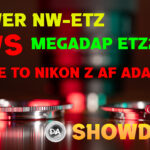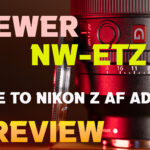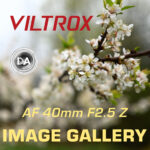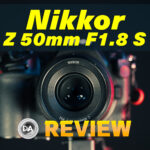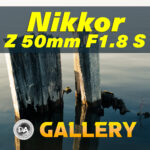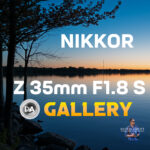
Megadap ETZ21 Adapter Review
When I first started using Sony E-mount, I was coming off a period of more than a decade where I had used the Canon EF ecosystem exclusively. It was a delight to find that there were adapters that would allow me to use my Canon lenses on my Sony camera as well. I used and reviewed a number of popular adapters from brands like Metabones, Sigma, and Vello, but found that they all came with some serious limitations. Over time I tired of used my EF lenses adapted for two primary reasons: 1) size and weight. 2) Inadequate performance. My favorite of the adapters proved to be the Sigma MC-11, but it added 125g to the weight of every lens attached to it and added another 26mm in length. This was necessary to adapt a DSLR mount to a mirrorless design. The optical path needs to be in a completely different place, so the optics need to be moved further away from the sensor to achieve proper infinity focus. I found that there was a huge spectrum of performance, too, with some lenses working fairly well and others being very inconsistent. Video AF, in particular, was pretty rough where it existed at all.
But here we are again looking at a new type of adapter, in this case adapting one mirrorless lens mount (Sony E-mount) to another mirrorless lens mount (Nikon Z-mount). The rules are a bit different this time. For one, the “flange distance” between the two mounts is similar, so now the adapter itself is just a few millimeters thick (2mm, to be exact), adding almost no additional bulk to lenses. There is a bit of weight, but, at 43g on my scale, it’s a third of what we dealt with the EF to FE adapters. And the performance seems to be better, too, with even some usable (though not flawless) performance for video. So is the Megadap ETZ21 Pro worth a $250 investment? Find out my thoughts by watching the video review below…or just keep reading.
Follow Me @ YouTube | Patreon | Instagram | Facebook | DA Merchandise | Flickr | 500px | X
__________________________________________________________________________________________________
Thanks to Megadap for providing a review sample of the ETZ21 Pro. As always, this is a completely independent review. All opinions and conclusions are my own. *The tests and most of the photos that I share as a part of my review cycle have been done with the 45MP Nikon Z8, which I reviewed here.
__________________________________________________________________________________________________
There will be some continuity between this review and another of the Neewer NW-ETZ adapter, as I’ve spent time with both in an attempt to get up to speed as to which adapter works better.
I’m reviewing the more recent ETZ21 Pro. There was previously an ETZ21 adapter as well that some of you may already own. What’s changed from the standard adapter to the Pro adapter?

There are two significant improvements. One is that rather than having to do firmware updates through a separate process, you can now run firmware updates through the camera body just as you would a Nikon lens. The second major improvement is to the mechanical design to allow for a better fit for Tamron lenses (and other third party lenses as well). There’s also a redesign to the lens release button to allow for a smoother mount/unmount process. Megadap repeatedly emphasizes that the performance of both adapters is the same, so this isn’t going to change the autofocus performances in any appreciable way.
In my research, I found that Megadap has released 5 firmware updates in the past year, which is encouraging, as that shows an ongoing commitment to improving their product not just via new releases. Improvements include squashing bugs with certain lenses, improving function, adding compatibility with new brands, and helping to eliminate issues like battery drain.

So does it work? The short answer is “yes”, and in many situations autofocus is remarkably ordinary. The shot above was taken with the ETZ21 Pro allowing my Sony FE 50mm F1.4 G Master (a beautiful lens!) to work on my Nikon Z8. And how precise is that focus at F1.4? Take a look here:

So let’s dive a little deeper.
Build and Design
As noted previously this is a pretty simple device in some ways. Essentially it feels like a metal lens mount detached from a lens.

At just 2mm thick, it essentially just goes onto the lens like a second mount.

You really won’t notice that the adapter is there once mounted, and I found that in the half dozen lenses that I tested with it, mounting and unmounting lenses remained relatively simple. Lenses fit well without any wobble. I prefer to remove the lens from the camera before removing the adapter from the lens, as there isn’t much left to grab from the camera mount once the lens is removed. The adapter is very, very thin. Always be sure to power down the camera before removing anything, however.
The improved release mechanism works nicely, and isn’t hard to depress for removing lenses.

The magic of the adapter is the dual sets of electronic contacts you can see at the back of the adapter. One is the backside of the Sony contacts, while the most prominent contacts (on the top of the image below) are the Nikon Z-mount contacts.

The front of the adapter has the pins that will come in contact with the Sony E-mount lenses.

Presumably there is some kind of processor hidden in there to do the focus algorithm conversions, though I wasn’t able to find any information on that.
The Megadap adapter definitely bests the Newer in one regard: it accurately delivers the EXIF information, whereas the Neewer seems to try to find a Nikon equivalent.

Both of the images in the comparison were shot with the Tamron 35-150mm F2-F2.8 VXD, and the Megadap shows the proper lens designation (including A058, Tamron’s internal code for the lens), while the Neewer reported VR 35-150mm F2-2.8G, which is clearly not accurate (this is not a G lens, nor does it have VR). The Megadap also reported properly for the two Sony lenses I tested, the Sigma lens, and the Viltrox lens. The Neewer reported the Sony lenses as VR 35mm F1.4G and VR 50mm F1.4G, while the Megadap properly recorded them as FE 35mm and 50mm F1.4 GM, respectively.
Megadap reports that at the moment their adapter is the only one to work with Nikon DX (APS-C) cameras, though that will almost certainly change in the future.
One final observation – you will be covering the weather sealing gasket on your Sony FE mount lens, if so equipped, and the adapter itself has no gasket, so there is some possibility that your weather sealing may not be as complete with the adapter in place, so bear that in mind.
Stills Autofocus with the ETZ21 Pro
I’ve been interested in seeing how these adapters work with good Sony lenses, including the 35mm and 50mm GM lenses, but also how they work with some third party lenses, including popular lenses from Tamron, Sigma, and Viltrox.
Let’s start with a practical test. I took the the Sony 50mm F1.4 GM on a hike using the ETZ21 Pro on my Z8, and also had an inexpensive Yongnuo YN 33mm F1.4 mounted on a Sony body. Both combos, in theory, shake out to about the same thing, as the YN 33mm is an APS-C lens, leaving a 50mm equivalence. Autofocus in bare form would obviously favor the GM lens, which has multiple XD (Extreme Dynamic) linear motors whereas the Yongnuo has a more basic single STM focus motor. In many situations the adapted Sony lens worked about as well as the Yongnuo (which actually focuses quite well), with one exception that stood out to me. When attempting to focus on a close subject, the Megadap combo would often stick on the background, requiring me to try to find a more obvious (bigger, higher contrast) subject in about the same focus distance I wanted and then going back to the desired subject. If I didn’t do that, focus looked like this:

The correct focus (which I achieved by pointing the camera basically at the ground first and then returning to correct subject. Focus would lock accurately then.) looks like this:

It’s worth noting that the Yongnuo in shooting the exact same shot immediately locked on the correct focus point.

Now clearly the GM lens delivered a superior looking image than the cheaper lens, but it does go to show that even an inexpensive native lens is going to autofocus a little better than an adapted lens in this situation.
Still, however, I was able to get all the shots that I wanted on my hike, and the end results were accurately focused. Shots like these ferns that still provided a pop of green in the mid-November death of vegetation.

Or this bare branch with just enough moss growing on it to provide a nice subtle color contrast against the background.

These shots were all at F1.4, but I also had good results when shooting landscape shots at smaller apertures.

So, I think I can safely say that autofocus accuracy is not a problem. At the margins, however, I think you’ll find a few places where autofocus doesn’t quite match what’s possible with a native lens.
What’s interesting, however, is that if you have a high speed autofocus system on Sony, you will continue to get fast autofocus on Nikon via adapter. I compared the focus speed of the Nikkor Z 50mm F1.4 lens and that the of Sony 50mm F1.4 GM lens via adapter back to back on my Z8, and there was no question that the focus speed (and arguably confidence) in this test actually favored the GM lens.

That makes sense, as really the adapter’s job is to send the correct communications from the lens to the AF system via the contacts, so a fast focusing lens should continue to be a fast focusing lens, with the only real slowdown being from the need to “reinterpret” the focus algorithms from one language (Sony) to another (Nikon). So a faster focusing lens (Sony GM) bests a slower focusing lens (Nikkor Z 50mm) even if there is a slight slowdown due to focus algorithms.
But what about the same lens? I had a unique opportunity to compare the Z-mount version of the Viltrox AF 16mm F1.8 with an adapter E-mount version of the same lens since I happened to have both of them on hand. In a pure focus test, I definitely found that the Z-mount version focused faster, with the adapted E-mount version being a little slower. Both would be fast enough for real world use, however.
I was also interested in seeing if the adapter affected the optical performance. In theory, it shouldn’t really affect sharpness, as there is no optical elements in the adapter themselves. No elements should mean no effect upon sharpness. As far as what I actually found, I don’t think there is any optical degradation. When I did a side by side comparison between the E-mount and Nikon Z-mount version of the Viltrox 16mm I found that there was just some give and take. I found the Z-mount version was a little sharper in the center…

…but the corner favored the E-mount version:

In other words, no consistent difference. I shot at different apertures and got similar results.
What I did find on a practical level was that when I was using the adapter I tended to get a bit of underexposure. I saw this when I compared the Viltrox 16mm lenses (the adapted lens metered at 1/400th, while the native mount lens metered at 1/250th), but I also saw it when just shooting during my hike. I ended up using exposure compensation for the second half of my hike and found that using 2/3rds of a stop of exposure compensation actually produced what I considered accurate exposure.
I didn’t see any kind of additional issues with flare or aberrations.

I was able to successfully use the Sony FE 35mm F1.4 GM (fast focus due to being a fast focusing lens), and got good results with the Tamron 35-150mm F2-2.8 VXD (fast, but not GM level fast), with good but slightly slower results coming with the Sigma 85mm F1.4 DN due to having a single STM focus motor.
Bottom line: the autofocus speed for stills you’ll get will depend a lot on the initial autofocus speed of the lens you’re adapting. Everything is slightly slower, but the better focusing lenses are fast enough that they are still fast even if you slow them down a bit.
At the same time, I wouldn’t want to rely on this combination for tracking fast action. Even with Nala trotting towards me at a moderately fast pace, I found that photos were fairly close but almost always backfocused a bit.



I think it is important to stay realistic about what adapted lenses can and cannot do. For most tasks, autofocus is plenty good enough. For fast action, with long telephotos, or for things like birding, I would say that using a native mount lenses is a smarter choice.
Video Autofocus
*These results will be easier to see in the video review for obvious reasons.
The good news is that you can still get autofocus during video capture, though there is a bit less confidence overall. I found that I encountered more pulsing during focus pulls, which is generally a byproduct of focus not being confident enough to lock. It would do a quick micropulse in the wrong direction sometimes.
I did a few tests walking towards the camera, and found that the results varied a bit. I did spot one principle difference with the Neewer NW-ETZ adapter, as I saw A) more reliable subject tracking with the Megadap adapter and B) seemed to get profile corrections in video with the Megadap but not the Neewer.
Using the Sigma 85mm F1.4 DN and its slightly slower autofocus motor I found that I got fairly decent tracking even at F1.4 as I walked towards the camera. Autofocus moved mostly smoothly with me and footage looked great. When I stepped out of frame, however, and focus moved to the background, autofocus did not pick me back up when I stepped back into frame.

I switched to the faster 50mm GM lens, and it was much more successful at picking me up when I stepped back in the frame.

So, as before, you’ll get your best results for video AF when using more confident lenses. This is definitely a far cry from the video AF experience I got back in the day adapting Canon EF lenses, though just know that if you put these adapted lenses in demanding situations you may be a bit disappointed, but for most work you’ll be just fine.
Conclusion
Switching to a new camera brand can be a daunting experience, as the sheer cost of selling what you have (typically at a significant loss) and then rebuying everything for the new brand is expensive. The Megadap ETZ21 Pro is a great way to bridge that gap, however, if you happen to be coming from Sony E-mount to Nikon Z. You can keep using the lenses you love without adding any bulk and only minimal weight, and that weight is right up close to the camera where you won’t notice it anyway.

Or perhaps you just have certain lenses that you love on E-mount but there isn’t an equivalent lens on Z-mount. The Megadap is a great way to use a favorite lens on two systems, or just keep an old friend to enjoy on a new platform.

Either way, this little adapter seems worth the money. It works effectively for stills other than not wanting to focus on a close subject periodically, and it even works surprisingly well for video, too, though perhaps not quite as seamlessly. My expectations were largely set by experience with former adapters, and I would say that the the Megadap ETZ21 Pro easily exceeded those. It’s a better adapting experience than any that I’ve personally experienced, matching even what I saw when adapting Canon EF to Canon RF mount using a Canon adapter. The fact that a third party adapter has pulled that off is pretty impressive, and I’ll personally enjoy using some of my favorite E-mount lenses on my Nikon camera(s) moving ahead.

Pros:
- Love how compact the adapter is
- Seems to enjoy a certain amount of first party support (firmware updates, lens profiles).
- Improved lens release button makes adding or removing a lens easier
- Autofocus for stills is generally very good
- Was able to track some action during video capture
- Ongoing support via firmware
Cons:
- Sometimes reluctant to focus on a close subject
- Some pulsing during video pulls
_________________________________________________________________________
GEAR USED:
Purchase the Megadap ETZ21 Pro @ B&H | Adorama | Amazon | Camera Canada | Amazon Canada
_______________________________________________________________
Purchase the Nikon Z8 @ B&H Photo | Adorama | Amazon | Camera Canada | Amazon Canada | Amazon UK | Amazon Germany
_________________________________________________________________
Want to support this channel? Use these affiliate links to shop at: B&H Photo | Amazon | Adorama | Camera Canada | Amazon Canada | Amazon UK | Ebay | Make a donation via Paypal
Buy DA Merchandise https://bit.ly/TWIMerch

Keywords: Megadap, ETZ21 Pro, Sony, E-mount, Adapter, Megadap Review, ETZ21 Review, Pro, ETZ21, Neewer, NW-ETZ, NW-ETZ, Neewer, Z, Z-mount, Z8, Review, mirrorless, Full Frame, Sports, Tracking, Dustin Abbott, Real World, Comparison, Handling, Focus, Portraits, Resolution, High ISO, Image Quality, Sample Images, Photography, 45MP, #letthelightin, #DA, #NIKON, #Z8, #NIKONZ8

